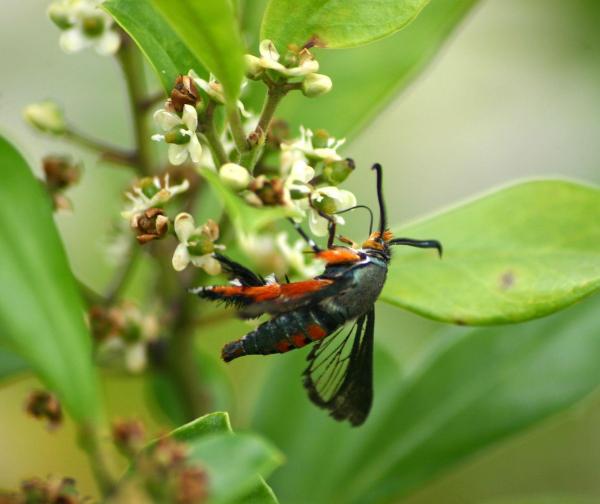Dripping Gardening August 8

I am asked that question many times every year. First of all, if you don’t know about squash vine borer and you live in Texas, you’re either very lucky or you’ve never tried to grow summer squash in your garden. Squash vine borers are one of the most common and destructive pests, killing countless summer and winter squash plants each and every year. Here’s how to identify squash vine borers, plus how to prevent them or stop them from killing your squash plants using organic methods.
Squash vine borers (Melittia satyriniformis) are the larvae of an attractive orange and black moth that is active during the day. Due to their similar appearance, many people mistakenly assume that adult squash vine borer moths are in the wasp family. They’re not – they’re moths.
Adult squash vine borer moths are pollinators. However, they have the unfortunate habit of laying their tiny copper-colored eggs on squash plants. After about ten days, squash vine borer eggs hatch, at which point the larvae chew their way inside the squash plant’s stem and slowly eat the plant to death.
Here’s how you know you’ve got a squash vine borer: one day you have a healthy squash plant. 24-48 hours later, you walk outside to find a squash plant that is limp and collapsed. You check the ground and the soil is plenty moist. You give the plant a gentle tug at its base to see if something may have eaten its roots (such as a vole), but it’s still firmly in the ground. Then you notice small holes in the leaf stems and/or the main stem of the plant with brown frass around the opening, indicating that something has chewed its way inside. You’ve got squash vine borers!
Usually, once the squash plant has gone limp from damage, there is no way to bring it back. This experience can be heart-breaking, especially if you’re relying on a small number of squash plants for your summer dinners.
If you examine your squash leaves you may find a cluster of small copper-colored eggs on the underside. This indicates you have a pest, either the squash bug (another squash pest) or the squash vine borer. Squash vine borers sometimes also lay individual eggs on a squash leaf or stem, rather than multiple eggs. Bottom line: if you see a shiny, copper-colored egg on your squash plant, it’s either a squash borer or a squash bug, and the eggs should be removed ASAP.
Four Methods to Prevent or Stop Squash Vine Borers
But what do you do if your plant is already infested? More often than not the only thing to do is to remove it and throw the poor plant in the garbage – not the compost heap!
But if you really want to go to the effort to try to fight this thing you can try these solutions:
1. Apply Bt (Beneficial Bacteria Spray).
Apply an OMRI certified Bacillus thuringiensis (aka “Bt”) spray on the leaf stems and main stem of the plant (not the flowers). Bt is a naturally occurring bacterium found in soils around the world. Research indicates that it is virtually harmless to non-target species (hence its approval for use in organic farming).
If you spray Bt on the stems and leaves of your squash plants once per week (or more if there’s a lot of rain), the squash vine borer’s eggs or larvae will be killed quickly, long before developing into large enough larvae to harm your squash plants. Many organic farmers use Bt spray, and it may be the most effective way to deal with borers and other squash pests.
You can even inject Bt into a squash plant’s stems if the larvae have already bored into the plant but the plant is not yet limp.
To further minimize any potential harm to pollinators (just in case the current science proves to be wrong), spray the plants as late in the evening as possible when daytime pollinators begin to go inactive, and avoid directly spraying the flowers.
2. Mulch the squash plant’s stems.
Keep the main stem of the plant covered with mulch as it crawls along the ground. This method helps prevent the adult Squash Vine borer moths from laying eggs on the stems. If the larvae bore into the main stem area of the plant, it doesn’t take them long to kill the plant.
If you go this route, also be sure to keep a careful eye on the leaves of your squash plants, since borers also lay eggs on the leaf stems or undersides of the leaves. As mentioned above: squash vine borer eggs are small, round, shiny and copper-colored, very similar in appearance to “squash bug” eggs (Anasa tristis).
The difference is that squash bugs lay multiple eggs in very tight clusters whereas borers will often only lay a single egg in one spot — or if laying multiple eggs, the eggs won’t be tightly clustered.
If you see either type of egg on your squash plant, remove them by hand immediately and get rid of them!
Also, if you see one leaf on your plant has gone limp and the others have not, this is a good indication that the limp leaf has a borer inside its stem, especially if you spot an entry hole. Cut the leaf and leaf stem off of the plant immediately, as close to the main stem of the plant as possible.
3. You may want to grow resistant squash varieties.
Most summer squash varieties are very susceptible to vine borers. However, there are other types of squash you can grow whose tough, thick stems are not nearly as susceptible to squash vine borers.
Squash in the Cucurbita moschata family are especially resistant. These include Butternuts, Tatumi, and my personal favorite Tromboncinos, a vigorous Italian heirloom that can be eaten early as a summer squash or allowed to grow huge to be stored as a winter squash.
If you grow Tromboncinos, be sure you have a lot of gardening space and, ideally, a fence or large, sturdy trellis they can climb on.
4. Use yellow bowls.
As you may have noticed, squash blossoms are yellow. As such, squash vine borer moths are highly attracted to the color yellow.
Many gardeners/farmers have luck trapping and drowning squash vine borers by placing a yellow bowl full of water in the garden. The color attracts the moths to the bowl. They then get trapped in the water and soon drown.
This method isn’t 100% effective but it is a good way to control the moth’s populations and determine, and if the moths are out. In our area, we have two big waves of squash vine borer moths: one in late spring/early summer and another wave in late August.
A couple of commonly prescribed methods for dealing with squash vine borers that I do NOT recommend:
1. Wrapping the stems of your squash plants in aluminum foil.
It gets too hot here to even think about using this method!
2. Spraying your plants with harmful synthetic pesticides.
This makes as much sense to us as smoking cigarettes while jogging.
I hope the information in this article helps you have a wonderful squash growing season!



